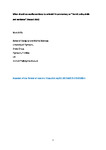When should we ascribe sentience to animals? A commentary on “Hermit crabs, shells and sentience” (Elwood 2022)
| dc.contributor.author | Briffa, Mark | |
| dc.date.accessioned | 2022-06-30T09:08:29Z | |
| dc.date.issued | 2022-06-30 | |
| dc.identifier.issn | 1435-9448 | |
| dc.identifier.issn | 1435-9456 | |
| dc.identifier.uri | http://hdl.handle.net/10026.1/19359 | |
| dc.description.abstract |
In a new review article, experiments on hermit crab behaviour are discussed in the context of possible animal sentience. Sentience can be defined as the ability to experience feelings such as pleasure or pain but there are also broader definitions that include elements of awareness. Here I suggest that of the different levels of awareness described as components of sentience, only the higher levels (assessment and executive awareness) seem distinct from the basic non-sentient cognitive tasks of gathering, processing and storing information, which are demonstrated by most animals. Studies that attempt to differentiate between basic cognitive functions and higher levels of awareness are rare for most animal taxa, including hermit crabs. Therefore, while results such as those obtained from studies of hermit crab behaviour are compatible with sentience they cannot yet be distinguished from simpler explanations based on basic cognitive functions, which we should prefer for the time-being. Nevertheless, hermit crabs are promising model systems for investigating awareness in animals. | |
| dc.format.extent | 1375-1380 | |
| dc.format.medium | Print-Electronic | |
| dc.language | en | |
| dc.language.iso | en | |
| dc.publisher | Springer | |
| dc.rights | Attribution-NonCommercial-NoDerivatives 4.0 International | |
| dc.rights.uri | http://creativecommons.org/licenses/by-nc-nd/4.0/ | |
| dc.subject | Hermit-crab | |
| dc.subject | Sentience | |
| dc.subject | Awareness | |
| dc.subject | Feelings | |
| dc.subject | Parsimony | |
| dc.subject | Decision-making | |
| dc.title | When should we ascribe sentience to animals? A commentary on “Hermit crabs, shells and sentience” (Elwood 2022) | |
| dc.type | journal-article | |
| dc.type | Review | |
| dc.type | Journal Article | |
| plymouth.author-url | https://www.webofscience.com/api/gateway?GWVersion=2&SrcApp=PARTNER_APP&SrcAuth=LinksAMR&KeyUT=WOS:000819268300001&DestLinkType=FullRecord&DestApp=ALL_WOS&UsrCustomerID=11bb513d99f797142bcfeffcc58ea008 | |
| plymouth.issue | 6 | |
| plymouth.volume | 25 | |
| plymouth.publication-status | Published | |
| plymouth.journal | Animal Cognition | |
| dc.identifier.doi | 10.1007/s10071-022-01633-5 | |
| plymouth.organisational-group | /Plymouth | |
| plymouth.organisational-group | /Plymouth/Faculty of Science and Engineering | |
| plymouth.organisational-group | /Plymouth/Faculty of Science and Engineering/School of Biological and Marine Sciences | |
| plymouth.organisational-group | /Plymouth/REF 2021 Researchers by UoA | |
| plymouth.organisational-group | /Plymouth/REF 2021 Researchers by UoA/UoA04 Psychology, Psychiatry and Neuroscience | |
| plymouth.organisational-group | /Plymouth/Research Groups | |
| plymouth.organisational-group | /Plymouth/Research Groups/Marine Institute | |
| plymouth.organisational-group | /Plymouth/Users by role | |
| plymouth.organisational-group | /Plymouth/Users by role/Academics | |
| plymouth.organisational-group | /Plymouth/Users by role/Researchers in ResearchFish submission | |
| dc.publisher.place | Germany | |
| dcterms.dateAccepted | 2022-04-30 | |
| dc.rights.embargodate | 2023-6-30 | |
| dc.identifier.eissn | 1435-9456 | |
| dc.rights.embargoperiod | Not known | |
| rioxxterms.versionofrecord | 10.1007/s10071-022-01633-5 | |
| rioxxterms.licenseref.uri | http://creativecommons.org/licenses/by-nc-nd/4.0/ | |
| rioxxterms.type | Journal Article/Review |



